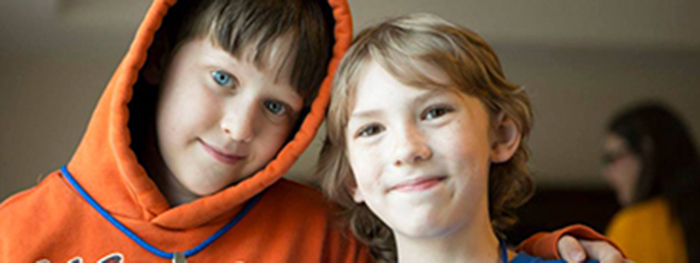Physical activity can boost your child’s ability to move, enjoy life.
We all know exercise is “good for us,” but the benefits can even be greater for children with arthritis – as can the downsides of being physically inactive. That’s why it’s especially crucial for children with arthritis to keep moving.
Fitness Facts
By and large, studies show that kidswith arthritis are deconditioned compared to their healthy counterparts. Specifically, they have less muscle strength and muscle endurance. They also have decreased aerobic capacity (needed for prolonged exercise) and anaerobic capacity (needed to perform intense bursts of activity); therefore, they tire faster during physical activity than kids who don’t have arthritis. These effects can be felt even when the disease is inactive.
On the flip side, studies also demonstrate that these conditions can be improved with exercise training. Aerobic and anaerobic capacity can be boosted, and resistance training can increase muscle strength and endurance.
Yes, They Can
Perhaps the most important thing to know about exercise for children with arthritis is that it does no harm. They can exercise and should.
“There are lots of studies that show that exercise training, whether it’s land or waterbased, is safe,” says Susan Klepper, PhD, PT, assistant professor of clinical physical therapy at Columbia University in New York City. “In other words, the number of joints that are swollen or painful don’t increase after exercise programs that generally run anywhere from one to three times a week, lasting six to 20 weeks long. These kids don’t report more pain, they don’t report increased morning stiffness or any other classic signs of disease.”
Big Benefits
In fact, a 2007 Canadian study published in Arthritis Care & Research found aerobic exercise helped children with arthritis. It looked at the effectiveness of high-intensity aerobic training (cardio-karate) versus low-intensity aerobic training (qigong, similar to tai chi) in 80 children with juvenile idiopathic arthritis (JIA), ages 8 to 16.
“Both groups improved a statistically and clinically important amount in physical function,” says the study leader, Brian Feldman, MD, professor of pediatrics, University of Toronto and staff rheumatologist at The Hospital for Sick Children.
Although the kids who did qigong stuck with the 12-week program the best, “both groups also commented on improved confidence with physical activity, improved balance and overall improved physical abilities,” reported Dr. Feldman.
In addition to these benefits, exercise may positively affect a common secondary condition associated with JIA, low bone mineral density (BMD). A 2007 review study published in Pediatric Physical Therapy and conducted by the University of Hartford in Connecticut looked at 37 articles on the risk of low BMD and children with JIA. Their conclusion: Weight-bearing activities, like walking, should be a part of exercise programs for kids with JIA but more research still needs to be done to figure out the amount, duration and frequency of the activity necessary to lower the risk of low BMD.
While you’ll want your child to avoid high-impact activities, the study indicated weight-bearing activities, such as jumping rope, skipping, step aerobics and tuck jumps, do seem reasonable depending on the child. Talk with your child’s doctor or physical therapist about the possibility of adding these or other weight-bearing activities to your child’s routine and which type of these activities might work best for him.
Finding an Exercise Match
All this glowing talk about exercise aside, finding the perfect activity for your child and getting her to stick with may not be easy. It took loads of trial and error, and a strong commitment on the part of Lynn Camino of Fort Wayne, Ind., to find an activity that her daughter, Sarah, could do pain-free.
Diagnosed with ankylosing spondylitis when she was 6, Sarah is now a 10-year-old fourth grader who enjoys horseback and bike riding, baseball, swimming for fun, bowling and moderate walking. She also likes playing sports games on her Wii when the weather keeps her indoors.
But finding the right fit didn’t come easily. Sarah tried ballet, competitive swimming and tennis but had to drop those. Satisfied with Sarah’s current level of exercise, Lynn is glad they didn’t give up. “I think it was really important to let Sarah find some activity that she could do to have a physical accomplishment,” she says.
Not surprisingly, Klepper has found that the optimal way to get kids to exercise regularly (an hour of moderate exercise daily, broken up any way) is to find something they like to do, like Sarah and Lynn did. “There are very few activities that I rule out,” says Klepper, though she’s not a fan of collision sports like football. Modifications may have to be made depending upon which of your child’s joints are involved, and it’s important to work with your doctor or physical therapist when selecting appropriate activities.
Children with multiple joint involvement, systemic or active disease will likely have a tougher time with exercise. Heading into the water may work for these kids or for those with trouble walking. Also, a tricycle or bicycle may provide an opportunity for comfortable exercise. “In my experience, there are very few kids who can’t do some form of exercise,” says Klepper.
A Family Affair
One of the best ways to help your child with arthritis become – and stay – active is to get your whole family to buy into exercise. Kids with arthritis often feel different because of their disease. If they’re exercising solo at home, they’ll again feel like the odd one out. So getting the whole family moving should improve the likelihood of your child participating because it is a group effort.
By making physical activity a family affair, evening walks can become a cherished part of your family’s routine – offering a time to talk and bond in addition to staying fit.
Source: Arthritis Foundation
By Linda J. Brown
http://www.kidsgetarthritistoo.org/living-with-ja/daily-life/staying-active/ja-exercise.php











